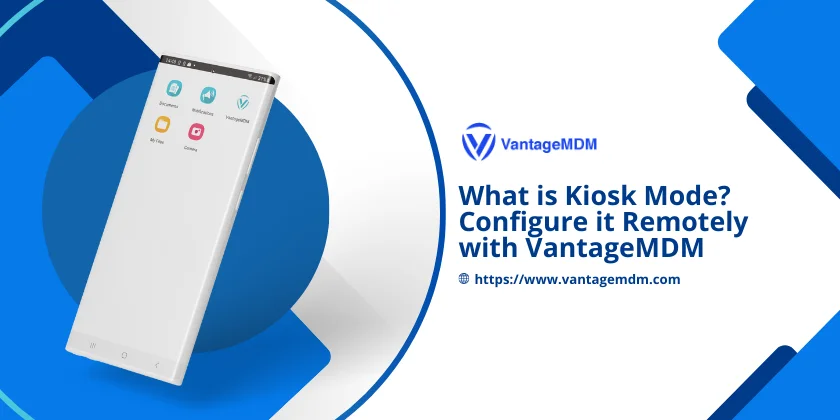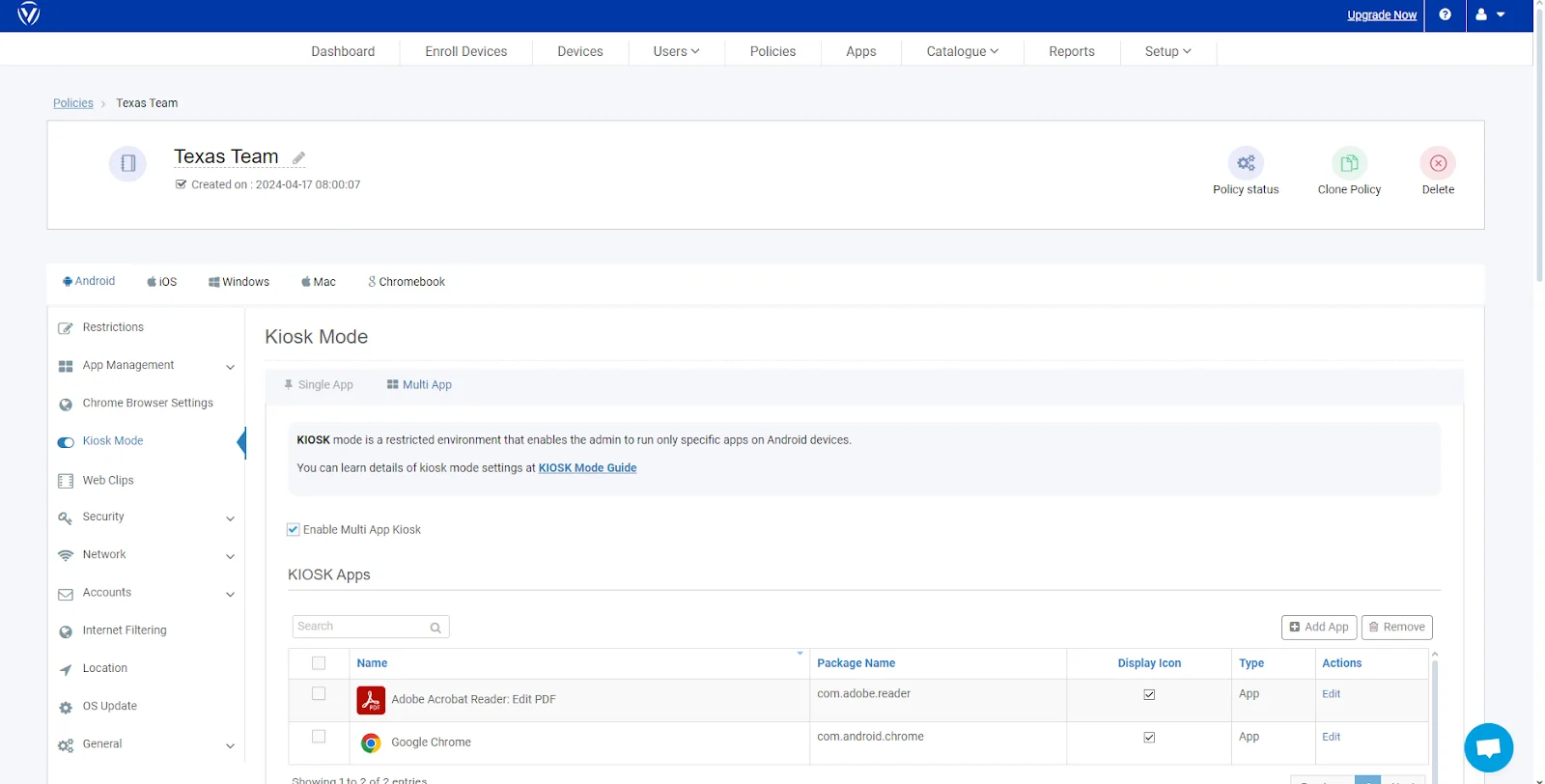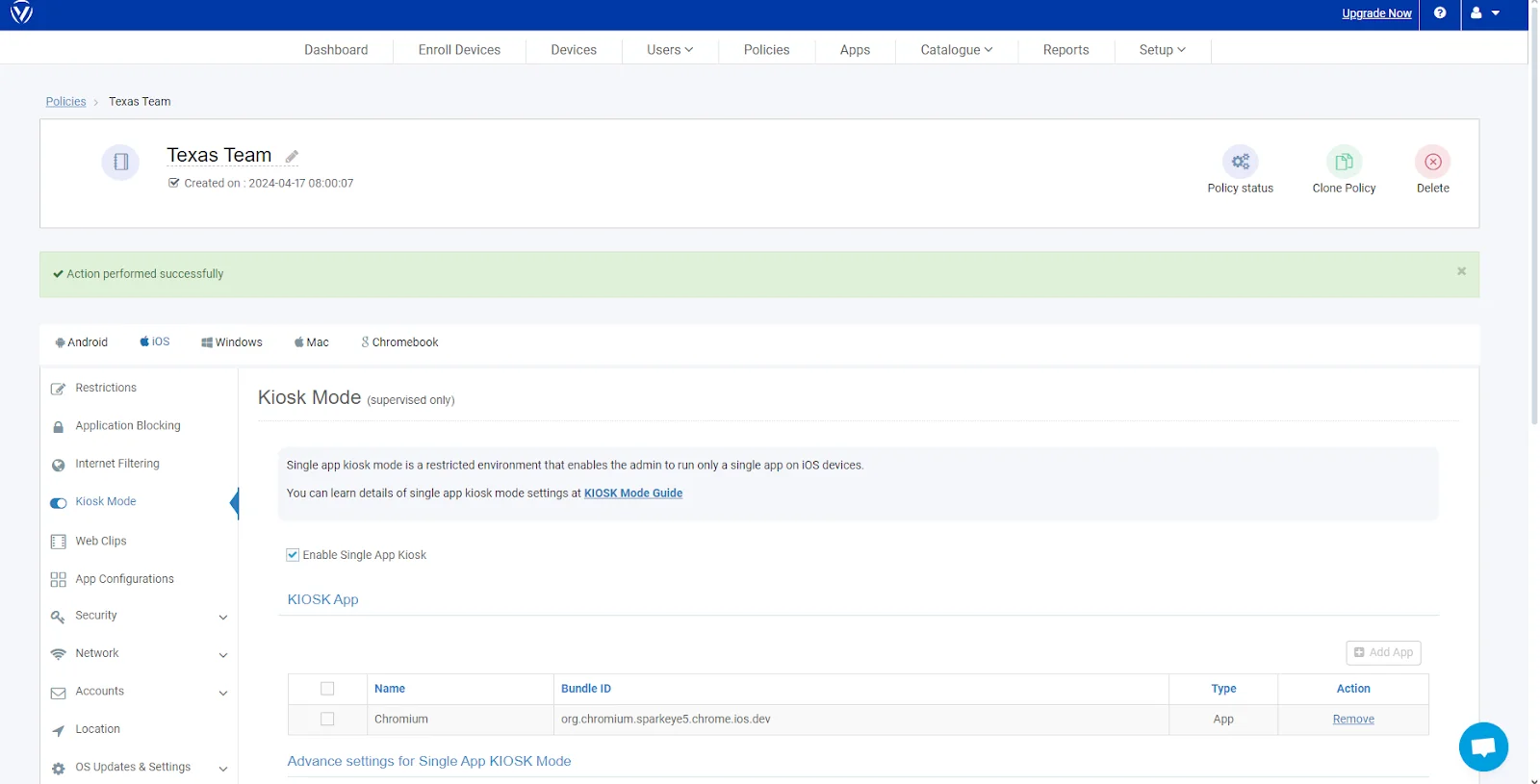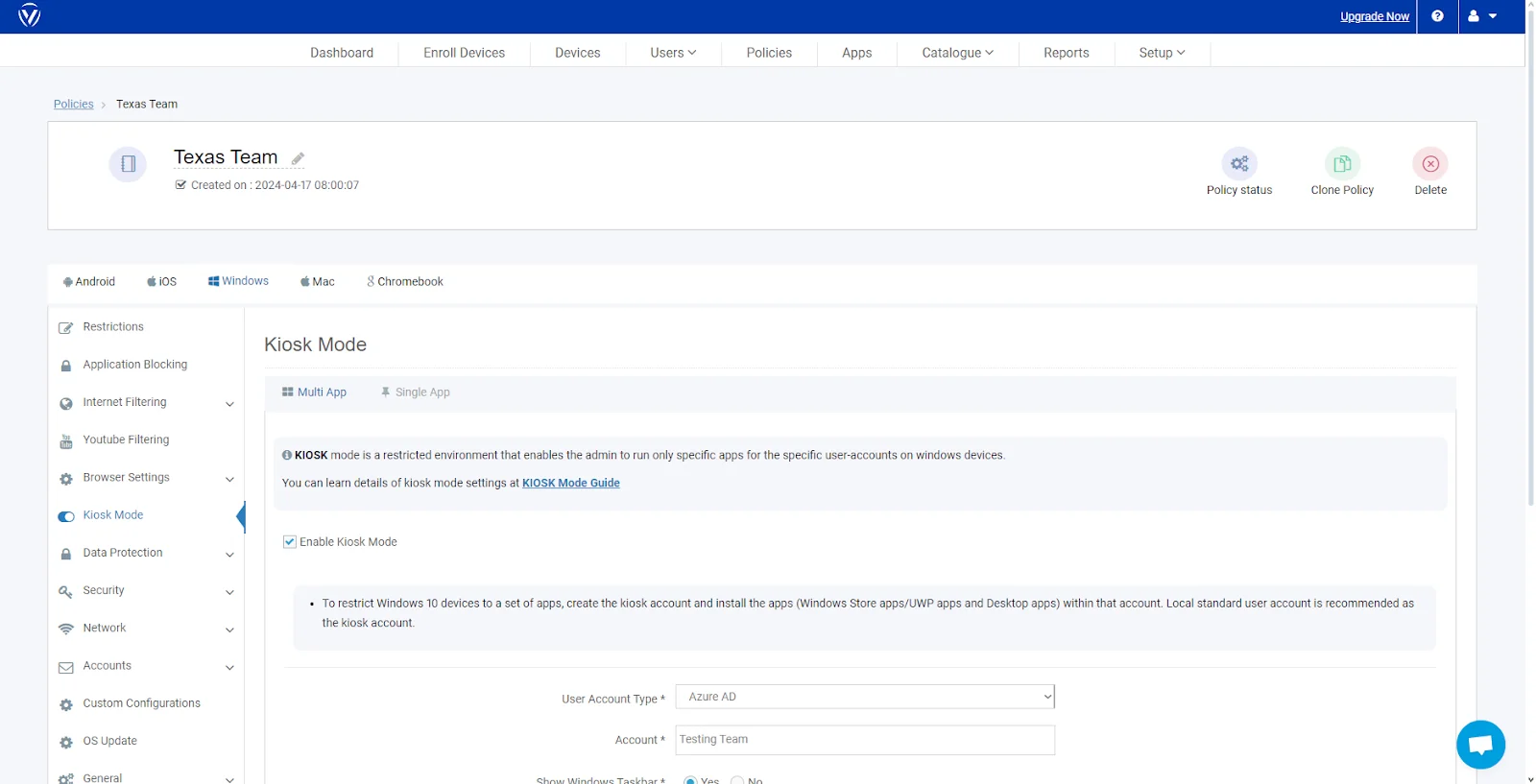What is Kiosk Mode? - Its Benefits for Various Industries

We use phones and tablets all the time now. But how do you make sure they're used right, like at work or in a store? Kiosk mode is the answer.
Kiosk mode locks a device down, so it only does one thing (or a few). It stops people from going to other apps or changing settings. This way, the device is only used for what it's supposed to do. Think of it like turning your regular tablet into a special tool.
A long time ago, kiosk mode was mostly used in public places where you could, for example, print a boarding pass. Now, businesses use kiosk software to make regular phones and tablets into tools that do specific jobs.
Why Does Kiosk Mode Matter?
Kiosk mode is helpful for businesses managing their devices. It turns them into single-purpose tools that are easy to use and secure. It's important because:
- It helps people focus: Workers stay on task when they can only use certain apps.
- It keeps things secure: Sensitive info stays safe.
- It's easy to use: Devices are simple.
- It saves money: Less data is used.
The Strategic Importance of Kiosk Mode in Modern Business Operations
Kiosk mode has evolved from a niche technical feature to a critical tool for organizations seeking to balance efficiency, security, and user experience. While commonly associated with self-service terminals in airports or retail environments, its applications address broader operational challenges across industries. Below are the key reasons businesses prioritize its implementation.
1. Mitigating Security Risks in Public and Internal Systems
Kiosk mode establishes controlled environments that minimize vulnerabilities inherent in shared or task-specific devices:
- Reduced Exposure to Cyber Threats: By restricting access to unauthorized apps, websites, or downloads, organizations lower the risk of malware infections. For example, a public library kiosk limited to catalog searches cannot execute suspicious email attachments.
- Sensitive Data Protection: In healthcare or finance, kiosk mode prevents accidental data leaks by disabling file transfers, screenshots, or access to unrelated accounts. A clinic check-in kiosk displays patient forms without allowing access to the device’s underlying operating system.
- Controlled User Permissions: Retailers, schools, or corporations ensure devices serve only their intended purpose. Demo tablets in stores run product videos but block attempts to modify settings or install unapproved software.
Example: A bank deploys kiosk mode on customer service tablets, enabling account balance checks while preventing access to internal banking portals or personal employee logins.
2. Optimizing Workforce Productivity
Distractions from non-essential apps or complex interfaces hinder operational efficiency. Kiosk mode addresses this by:
- Task-Specific Access: Employees interact solely with tools relevant to their roles. Warehouse staff using inventory scanners see only stock management apps, eliminating distractions from messaging platforms.
- Streamlined Processes: Devices boot directly into required applications, reducing setup time. A delivery driver’s tablet launches route optimization software immediately, bypassing home screens or unrelated menus.
- Error Reduction: Simplified interfaces minimize accidental inputs. Manufacturing line tablets with large, touch-friendly buttons prevent costly mistakes during quality control checks.
Example: Airlines equip ground staff with kiosk-mode devices that auto-launch baggage tracking systems, ensuring focus during high-pressure turnaround times.
3. Cost-Effective Device Management
Organizations achieve financial savings through:
- Hardware Repurposing: Standard tablets or smartphones replace expensive custom hardware. A restaurant converts consumer-grade tablets into payment terminals, avoiding proprietary POS system costs.
- Lower IT Overheads: Restricted functionality reduces software conflicts, viruses, and user-induced errors. Schools using kiosk mode on shared classroom tablets report fewer repair requests compared to fully accessible devices.
- Extended Device Lifespan: Limiting app usage reduces processor strain and battery wear. Museum guide tablets running a single interactive app outlast those used for multitasking.
Example: Logistics firms repurpose retired smartphones as warehouse scanners, using kiosk mode to lock them into barcode-reading applications.
4. Intuitive User Experiences for Diverse Audiences
Kiosk mode bridges the gap between technical functionality and accessibility:
- Minimalist Interfaces: Customers, patients, or employees navigate clearly labeled options (e.g., “Pay Now,” “View Schedule”) without confusion from extraneous features.
- Guided Interactions: Step-by-step workflows prevent user errors. Hotel check-in kiosks prompt guests to insert IDs, select rooms, and confirm stays in a fixed sequence.
- Reduced Training Demands: Simplified systems enable quick adoption. Temporary retail staff operate inventory kiosks confidently after a brief orientation.
Example: Healthcare providers deploy self-check-in kiosks that guide patients through insurance verification and symptom reporting, cutting front-desk congestion.
A Versatile Solution for Operational Challenges
Kiosk mode addresses universal business needs—security, productivity, cost management, and user satisfaction—through adaptable configurations. Its value lies in its ability to:
- Secure devices without complex IT infrastructure
- Align technology with specific workflows
- Reduce long-term operational expenditures
- Serve both tech-savvy and novice users effectively
Implementing kiosk mode requires minimal technical expertise, as most mobile device management (MDM) platforms offer user-friendly configuration tools. For industries ranging from education to hospitality, it represents a pragmatic approach to modernizing operations while maintaining control over device ecosystems.
What is Kiosk Mode with VantageMDM? Configure it Easily
VantageMDM empowers its users to streamline kiosk mode in a few simple steps. Its easy-to-use console allows administrators to enroll and set up kiosk mode with approved applications, policies, and device settings.
Configuring Kiosk Mode on Android
- Click Policies on VantageMDM admin panel.
- Select Android from the policy detail page.
- Click on Kiosk Mode option, and select Single or Multi App Mode.
- Add essential applications after enabling kiosk mode.
- Click Save & Publish.

Configuring Kiosk Mode on iOS
- Select iOS from the policy detail page.
- Click on Kiosk Mode option, you can select Single App Kiosk Mode
- Add essential application.
- Click Save & Publish.

Configuring Kiosk Mode on Windows
- Select Windows from the policy detail page.
- Select Multi App or Single App as shown below.
- Configure applications and settings that are easy to follow.

Explore: Kiosk Software
Kiosk Mode: Practical Uses Across Industries
Kiosk mode restricts devices to specific tasks, creating focused, secure environments. Its flexibility makes it valuable across sectors—here’s how different fields put it to work:
Education: Cutting Distractions, Boosting Focus
- Tamper-Proof Testing: Tablets or computers locked into exam apps prevent students from accessing browsers, messaging, or other apps during tests. This minimizes cheating risks and keeps assessments fair.
- Controlled Learning Tools: Kiosk mode for schools empowers schools deploy devices preloaded with textbooks, schedules, or assignment portals. Kiosk mode blocks social media or games, ensuring students stay on-task during class hours.
- Teacher-Friendly Management: Educators disable non-educational apps without manual monitoring. A student attempting to open YouTube during a lecture? The app simply won’t launch, saving time and frustration.
Retail: Smoother Operations, Happier Customers
- Dynamic Digital Displays: Replace static posters with tablets running loops of promotions, new arrivals, or seasonal deals. These eye-catching setups require minimal staff intervention and update remotely.
- Frictionless Self-Checkout: Customers scan items and pay independently using locked-down tablets. Reduced wait times improve satisfaction, while staff focus on assisting rather than ringing up orders.
- Budget-Friendly POS Systems: Standard tablets become secure payment terminals with kiosk mode. Businesses skip expensive hardware, repurposing existing devices for card swipes, receipts, or inventory checks with MDM for retail industry.
- On-Demand Product Info: Shoppers access specs, stock levels, or loyalty rewards via kiosks. Fewer “Where’s this item?” questions free employees for complex tasks.
Transportation & Logistics: Safety and Efficiency
- Automated Driver Logs: Kiosk mode transforms tablets into electronic logging devices (ELDs) that track driving hours, routes, and breaks. This ensures compliance with safety regulations and reduces paperwork errors.
- Real-Time Travel Updates: Airports, bus stations, or train hubs use kiosks to display live schedules, delays, or gate changes. Passengers stay informed without overwhelming staff with repetitive queries.
- Self-Service Ticketing: Travelers purchase tickets or print boarding passes via kiosks, reducing lines. Drivers and attendants avoid handling transactions, focusing instead on operational tasks.
Also read: Use of MDM in Logistics and Transportation
Healthcare: Security Meets Patient Care
- Private Data Access: Doctors and nurses view patient records on devices locked to medical software. No accidental app openings or ads ensure confidentiality and streamline workflows.
- Educational Kiosks: Waiting areas feature tablets with vetted health resources—symptom checkers, vaccine info, or clinic policies. Patients avoid unreliable online sources while waiting.
- Streamlined Administrative Tasks: Kiosks handle appointment bookings, prescription refills, or bill payments. Receptionists spend less time on routine tasks, improving patient-staff interactions.
Hospitality: Enhancing Guest Experiences
- Interactive Guides: Hotels use kiosks to showcase amenities, local attractions, or event calendars. Guests access info without flagging down busy staff, especially during peak hours.
- Quick Check-In/Check-Out: Visitors bypass front desk lines by scanning IDs, selecting rooms, or printing keys via kiosks. Staff reallocate time to resolving issues like room upgrades or maintenance.
Government: Transparent and Accessible Services
- Public Information Hubs: Kiosks in offices or libraries display tax guidelines, voting details, or permit processes. Citizens access accurate info without sifting through dense government websites.
- Automated Applications: Residents submit paperwork, pay fines, or renew licenses via self-service kiosks. Agencies reduce manual data entry, cutting processing times and errors.
Why Kiosk Mode Matters?
Kiosk mode isn’t flashy, but it solves real problems:
- Security: Devices can’t stray into unapproved apps or websites.
- Cost-Efficiency: Repurpose existing hardware instead of buying specialized equipment.
- User Experience: Simplifies interactions for employees, customers, or students.
While setup requires initial effort, mobile device management (MDM) tools simplify ongoing control. Updates, app restrictions, or access permissions adjust remotely—no need to manually reconfigure each device.
For industries juggling security, budgets, and efficiency, kiosk mode offers a straightforward fix. It won’t revolutionize workflows overnight, but it eliminates countless daily friction points.
